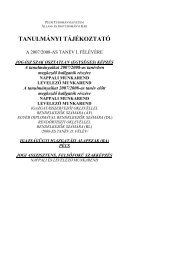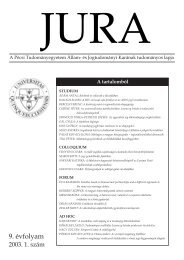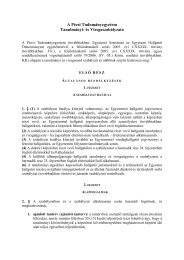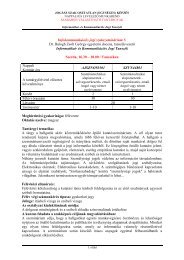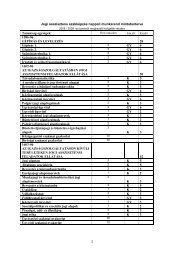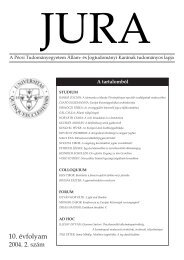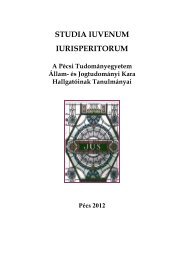2012. évi 2. szám - Jura - Pécsi Tudományegyetem
2012. évi 2. szám - Jura - Pécsi Tudományegyetem
2012. évi 2. szám - Jura - Pécsi Tudományegyetem
- TAGS
- jura
Create successful ePaper yourself
Turn your PDF publications into a flip-book with our unique Google optimized e-Paper software.
220 Ulrich Karpen: Migration and Human Rights – Challenges and Chancesin fact, is to open national borders for citizens ofother member states, basically in order to facilitatetransborder migration. During the court proceedingsin re Zambrano national governments of 9 memberstates argued that it is not an EU law case but a purelynational matter (of Belgium). Without going to muchinto detail, one can say that it would mean to set asidenational law concerning foreigners, if protection byEU citizenship is granted in such national mattersto foreigners from third states. The legislators of themember states are deprived of their competence toregulate on admission and stay of citizens of thirdstates according to their own options.I think that these two cases shed some light onsome factual and legal problems of migration. Iwould like to approach them a little bit more in threesteps: firstly, I will present some facts of migration inEurope; secondly, I shall give a quick overview of theHuman Rights topics of migration; thirdly, I wouldlike to depict some shortcomings of the migrationsituation in Europe and instruments to improve it:challenges and possibilities.1. Definitions, Data, FactsMigration means – as we all know – that a persontransfers the centre of his/her life and work to anotherplace. But in our context we mean – of course– transnational migration – within the European Union– and international migration, the latter by citizensof states which are not EU member states (i.e. thirdstates). In dealing with problems and possibilitiesof migrants – integration, naturalization, rights andduties – we need, however, to encompass a largergroup. The term for this group is “people with migrantbackground”. These are not only the migrantsthemselves, but also young persons, who have beenborn in an EU member state, but have at least one parentwho comes from another member state or from anon-European state. They mostly have no migrationexperience themselves and often are naturalized.The legal situations of migrants differ from countryto country in Europe, but the basics are similar. Inin the following, I may focus on migrants in Europe.In a globalized world, migration is an ubiquitousphenomenon, and it will certainly grow. I think weare privileged to live in Europe and in the Union, acontinent which is the goal, aspiration and hope forso many migrants from all over the world.Let me present a few data. In 27 member statesof the European Union with half a billion peoplewe have 20 Mio. non-European citizens and approximately60 Mio. migrants. In Germany, with 80Mio. people, we have 16 Mio. people with migrationbackground, half of them with German citizenship.From the remaining approx. 8,0 Mio. migrants 2,3Mio. are migrants from EU member states. In Hamburg,my home city, with 1,8 Mio. inhabitants, onethird (510.000) of the population have a migrationbackground, with 223.000 not being German citizens.As in all other countries the majority of people withmigration background are young people. Migrantscome from all over the world, in Europe namely fromTurkey, Afghanistan, Iran, Serbia a.s.o. In Hamburg,interestingly enough, 18% of the migrants are fromTurkey, 13% are from Poland. In Hamburg, 4 % of thepopulation are from Poland.In Bergedorf – one of our7 districts – we have 7% with a Polish background.I think we all agree, that the goal of migrationpolicyof society and government must be socialintegration in the sense that unity in diversity can beachieved. This is, at least, the main idea of buildingEurope, as spelled out in Art. 3 of the Lisbon Treaty.How could that be different in the member states?This means, actually, that only one model of four possiblemodels is qualified to further peaceful coexistencewithin co-citizens with migration background.A society must evaluate possibilities and dangersof the following concepts: inclusion (establishing amulti-cultural society); assimilation (leading towardshomogenity); separation (exclusion of parts of societywhich may lead to parallel structures of society);marginalization (creating minorities and causingisolation of individuals).All these possible approaches have been treatedin history and actually find support in our politicalsceneries. I think, however, that integration in pluralityis the best way: “Let’s enjoy our similarities andcelebrate our differences.”But along with which data should one evaluateintegration processes and results? Which are thecore-indicators, the common set of values to measureprogress against and monitor policy? Which are thefields of more successful and less effective integration?Let me mention first the world of economy. Tofind a job, to earn one’s own money, to be independentis a primordial goal of any individual. Occupationalintegration requires education. Does it reallymatter if some politicians hypocritically advocateintegration as humanistic behaviour and do, in fact,mean that in our particular demographic situationwe need a young work force? And here in economywe need heroes: like Vural Öger,the successful Turkishbusinessman.The second field of integration is of course culturein the widest sense. The underrepresentationof young people with migration background isdramatic. To learn the language of the country, itssocial values, its discipline is essential for fruitfulJURA 2012/<strong>2.</strong>



